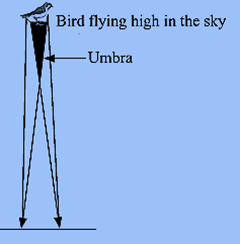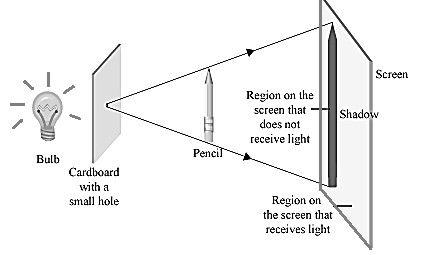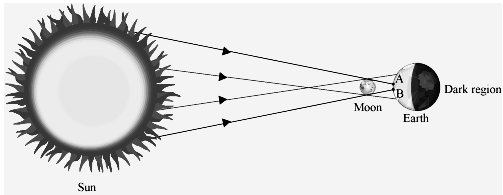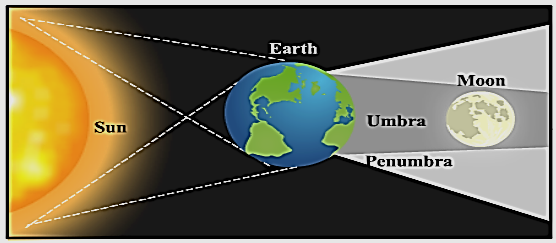Chapter-17-Effects of Light
Maharashtra Board-Class 7th-General Science-Chapter-17
Solutions
Question 1:
Fill in the blanks .
(a) When the beams from the headlights of a car fall on an object in the night , the shadows called ............. and ..................... can be seen.
(b) During a lunar eclipse the shadow of the ............. falls on the ......................... .
(c) During a solar eclipse the shadow of the .............. falls on the ................
(d) Various shades of colour are seen in the sky at sunrise and sunset due to ........................ .
(a) When the beams from the headlights of a car fall on an object in the night , the shadows called umbra and penumbra can be seen. (b) During a lunar eclipse the shadow of the Earth falls on the Moon. (c) During a solar eclipse the shadow of the Moon falls on the Earth. (d) Various shades of colour are seen in the sky at sunrise and sunset due to scattering of sunlight.
Question 2:
Give reasons.
(a) Space beyond the earth's atmosphere appears dark.
When sunlight is scattered by the particles present in the atmosphere, the surrounding gets illuminated and appears bright. In space, there is a vacuum beyond earth’s atmosphere, due to which there is no medium for scattering of sunlight. Thus, it appears dark.
(b) We are able to read while sitting in the shade.
Light is required for seeing and reading. The sun is an extended source of light which is far away from the earth. The sunlight casts a shadow of the object, in its path, on the earth. This shadow has no umbra, but penumbra which is nothing but the shade. There is a sufficient amount of light available to read in the shade. Hence, we are able to read while sitting in the shade.
(c) We should not observe the solar eclipse with naked eyes.
The earth receives the harmful ultra-violet rays from the sun. During a solar eclipse, even if brightness of the sun is less, the ultra-violet rays reach the earth. If the solar eclipse is seen/watched with naked eyes, the ultra-violet rays directly enter our eyes and damage vision. Hence, the solar eclipse should not be observed with naked eyes. We should always use some device such as binoculars or dark glass while watching the sun during solar eclipse.
Question 3:
Give some example of scattering of light that we come across in day-to-day life.
Some example of scattering of light that we come across in day-to-day life are:
Question 4:
Why is the shadow of bird flying high not seen on the earth?
The sun is an extended source of light which is extremely bigger than the earth. When a bird flies (at relatively shorter height from the ground), there is a formation of umbra and penumbra on the ground. But, as they fly high in the sky, their umbra becomes smaller and smaller and eventually disappears. At the same time their penumbra becomes more and fainter and then disappears. As a result, the shadow of the bird flying high is not seen on the earth. 
Question 5:
Why is a penumbra not obtained from a point source?
Scattering of light emerging from a point source does not take place. Thus, only dark shadow of the object placed in front of the point source is obtained. (See figure)

Question 6:
Answer the following questions in your own words.
(a) What is meant by scattering of light ?
The ability of light to spread in various directions is known as scattering of light.
The light rays hit the molecules, dust particles and other tiny particles present in the atmosphere and get scattered. When the scattered light rays enter our eyes, we perceive the light. A beam of light, blue sky, reddish appearance of sun are all effects of scattering of light.
(b) Does the shadow really vanish in the zero shadow condition?
In the zero shadow condition, the shadow does not really vanishes. On the zero shadow day the sun reaches exactly over our head Thus, the shadow formed just beneath the object because of which we are not able to see it and hence appears to be vanished.
(c) Will the laser beam be seen if it passes through a glass box which contains a lighted incense stick?
Yes, the laser beam will be seen if it passes through a glass box which contains a lighted incense stick. This is because Scattering of light is required/necessary, for a ray of light to be visible, the laser beam will be scattered by the smoke particles formed in the glass box due to burning of incense stick. Due to this scattering, the path of laser beam will become visible.
Question 7:
Discuss and write.
(a) Write a science based paragraph on 'What if the sun did not rise?'
If the earth stops revolving, the part of the earth opposite to the sun would never face the sun. Thus, the sun would never rise at that part. Following are its effects/consequences : Temperature of the part of earth facing the sun, would increase tremendously. This would lead to faster evaporation of water and there would be no rainfall. As a result, plant as well as animal life would come to an end.
(b) What efforts will you make to remove the misconceptions about eclipses?
We will make people understand and accept the fact that an eclipse is a natural phenomenon like rain, spectrum, seasons. For which, we will take following steps : We will convince people that the intake of food during the period of eclipse does not cause any ill effect on health.
(c) Various eclipses and the conditions during the period.
There are two types of eclipses known as Solar eclipse: It occurs when the Moon comes in between the Earth and the Sun and the Moon's shadow falls on the Earth. The solar eclipse occurs only on the new moon day. Two types of solar eclipse are: An annular solar eclipse : It is seen/visible from the part of the earth where a very small portion of the umbra of the moon falls. It is seen that the pat of solar disc, except the peripheral ring, is completely covered by the moon. The edge of solar disc appears like an illuminated ring.
Total Solar eclipse: It is visible from within the part of the earth where the umbra of the moon falls. The solar disc is completely covered by the moon. Darkness spreads on the part of the earth where the shadow of the moon falls.
Total lunar eclipse: When the total Moon comes under the shadow of the Earth.
Partial lunar eclipse: When the partial Moon or some part of the Moon comes under the shadow of the Earth.
Question 8:
Explain the difference:
(a) Point sources and extended sources of light.
Point Source of Light
Extended Source of light
A point source is tiny in size
It is bigger in size
It is that source of light which forms only the umbra region on the screen of the shadowed object.
It is that source of light which forms umbra as well as penumbra region on the screen of the shadowed object.
eg: Light coming from a tiny hole is a source of light
eg: Sun is an extended source of light
(b) Umbra and penumbra.
Umbra
Penumbra
The Umbra is a dark
The Penumbra is faint
It is the part of the shadow where all of the light from the source is blocked by the shadowing object.
It is the region around the umbra where the light from the source is partially blocked by the shadowing object.
It is formed using an extended source of light as well as point source of light.
It is obtained only from extended source of light.
A total eclipse obtained from the part of Umbra
A total partial eclipse obtained from the part of Peumbra
Click on below link to Download PDF
MSBSHSE-Class 7-General Science-Chapter-17-Effects of Light-Notes
MSBSHSE-Class 7-General Science-Chapter-17-Effects of Light-Solutions
MSBSHSE-Class 7-General Science-Chapter-17-Effects of Light-Book
| Main Page : Class 7th MSBSHSE – General Science - All chapters notes, solutions, videos, test, pdf.
Books : Maharashtra Board-Class 7 Science Text Books – Chapter wise PDF for download Videos : Video playlist of Class7- General Science -All Chapters Previous Chapter : Chapter 16 : Natural Resources - Online Solutions Next Chapter : Chapter-18- Sound : Production of Sound-Online Solutions |